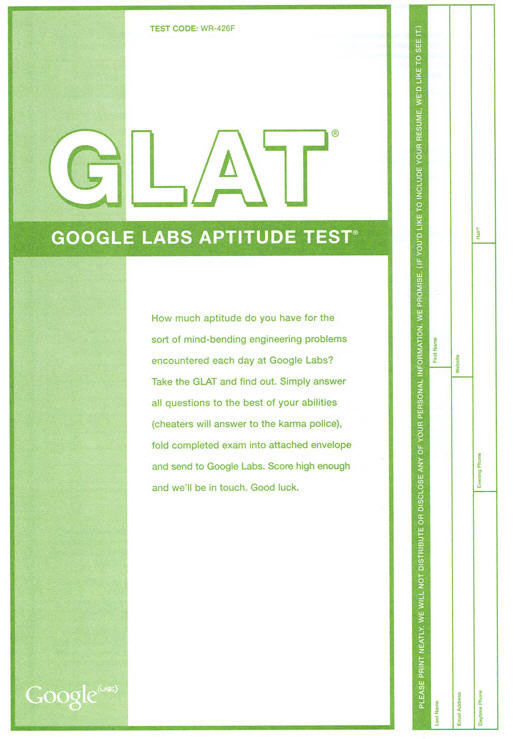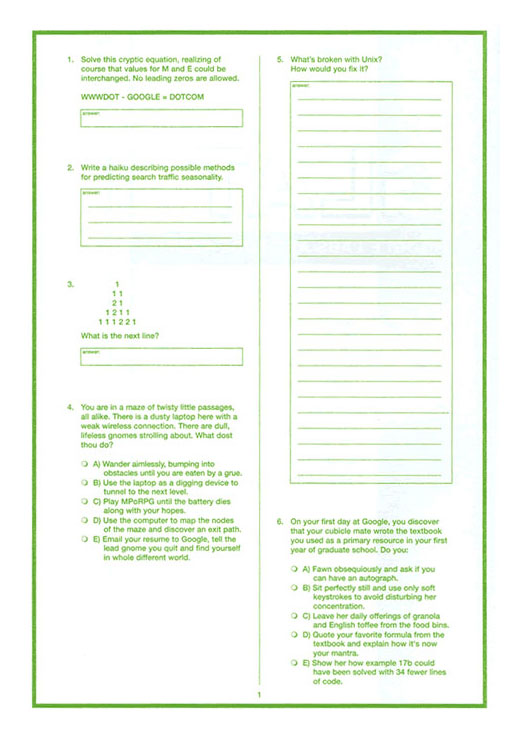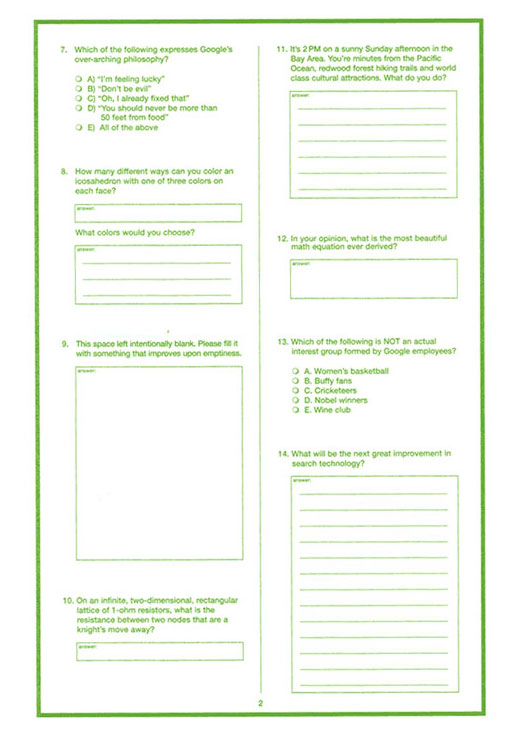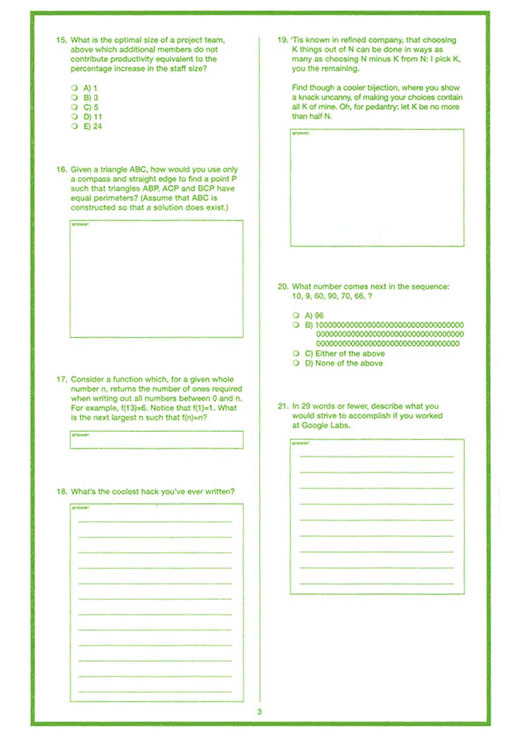The GLAT
Test your knowledge of mathematics, computers, and Google culture by taking the GLAT challenge! Google’s unconventional standardized test, which it used as a recruitment tool in the early 2000s, is reprinted in The Google Story.
Do you have what it takes to score well on the GLAT? Take a stab at answering the questions, then check your work against the answer key below, which we’ve assembled with some help from math whizzes. Don’t peek!
Answer Key
Hover/tap on a question below to see the answer
Question #1
Answer to Question #1
The equation is a straightforward substitution encryption. Hint: To make the code easier to crack, write it out in this form:
WWWDOT
-GOOGLE
——————–
DOTCOM
Then, it’s a matter of finding the correct digits to substitute for the letters. This can be done through the brute force method of trial-and-error, but a more Googley way to solve it would be to write a computer program. See this MathWorldpage for some suggestions. Hopefully you’ll end up with:
777589
-188103
——————–
589486
* As the question noted, the M and E are interchangeable. If you make M=3 and E=6, the answer would be 589483.
Question #2
Answer to Question #2
Since there are no right or wrong answers in poetry, we offer no suggestions beyond a reminder to follow the haiku syllable rule (5 – 7 – 5). But we are interested in your creations. Have a poem that you’d like to share? Email GLAT (at) thegooglestory.com
Question #3
Answer to Question #3
This is a deceptive puzzler. Hint: Try reading each digit aloud from left to right.
One
One One
Two One
One Two One One
One One One Two Two One
Still stumped? Here’s a second hint / spoiler:
One
One One
Two One
One Two, One One
One One, One Two, Two One
The Solution: Each line describes the numbers in the line above it. So the next line would read: 312211 aka Three Ones, Two Twos, One One.
Question #4
Answer to Question #4
Thou dost answer as thou please.
Question #5
Answer to Question #5
There are no shortage of opinions on this. The folks at MathWorld have an amusing take.
Question #6
Answer to Question #6
D. Or, if you can, E.
Question #7
Answer to Question #7
People are most familiar with Google’s mantras A) “I’m feeling lucky” and B) “Don’t be evil,” but the answer is actually E) All of the above.
Question #8
Answer to Question #8
The question “What is an icosahedron?” would be enough of a challenge for most of us, nevermind the calculations about how many ways to color it. As it happens, icosahedron is the technical term for a 20-sided solid, though the question doesn’t specify whether the icosahedron is regular (symmetric) or irregular (having sides of varying shape and size). If we’re not talking about a regular icosahedron, the answer is:
3^20 (three to the power of 20)
In the case of a regular icosahedron, you’d have to take into account rotational equivalency and bisymmetry, reducing the number of combinations, for an answer of:
(3^20)/20 (three to the power of 20, all divided by 20)
The second part of the question — what colors to choose — is of course a matter of personal preference, but Googlers will expect you to have a good reason for your choices. David opts for red, white and black, Maryland Terrapins colors, while Mark, a lifelong Philadelphia Flyers fan, picks orange, black, and white.
Question #9
Answer to Question #9
How to improve upon emptiness? Some suggestions:
— Write out beautiful math equations (see #12)
— Paste a photograph of a loved one.
— Fill it with Google text ads
— Draw a map to buried treasure.
Question #10
Answer to Question #10
We’re still working on this one. If you’re interested, see a thorough examination of the problem at MathWorld and Cruftbox.com
Question #11
Answer to Question #11
Surf? Surf.
Question #12
Answer to Question #12
Ah, beauty. We won’t attempt to judge the merit of the many possible answers to this question, but rather leave it to the eye of the beholder. Our own nominee is the equation that yields the magical number phi (1.618…), the “golden ratio” that is found abundantly in nature, in Man, sunflowers, seashells, as well as the pyramids, the Parthenon, Renaissance art, even the DaVinci Code. Its beauty has stood the test of time.
Question #13
Answer to Question #13
D.
Question #14
Answer to Question #14
Sergey Brin has one suggestion that appears in Chapter 25 of The Google Story. It may take some time yet, but it is inevitable.
Question #15
Answer to Question #15
B
Question #16
Answer to Question #16
This problem calls for finding the Isoperimetric point. A Cornell student, Elliott Back, had posted this answer on his Web site about 15 years ago. It looks right to us:
Draw a circle around C of radius (a+b-c)/2. This makes it easy to draw circles around A and B which are tangent to C. You have three small circles–now draw a final circle outside and tangent to circles A, B, C. The center of this circle is P. This is also known as Apollonius’ problem.
Question #17
Answer to Question #17
199981. This requires a computer program to solve, or a lot of patience.
Question #18
Answer to Question #18
If you’re interested in cool hacks, Tara Calishain’s book Google Hacks is a good place to turn. We also like the many cool and useful things being done with Google Maps. See the Google Maps Mania blog for a good collection.Question #19
Answer to Question #19
The first half of the question is a fancy way of stating the binomial coefficient:(n, k) = (n, n-k)
An identity which solves the problem is (n-1, k-1) + (n-1, k) = (n, k).
Or, in words, “I pick k-1, you pick k.” Thanks, Elliott.
Question #20
Answer to Question #20
Hint: Write out the numbers, one below another.
ten
nine
sixty
ninety
seventy
sixty-six
The answer: Each number, when spelled out, is the largest for that given word size. Ten is the largest number with three letters; nine the largest with four. Thus, the next line in the series is the largest number with nine letters. That number is ninety-six, so the correct answer is A.
Question #21
Answer to Question #21
We’d love to know your ideas as we continue to cover Google and work on future editions of The Google Story.



